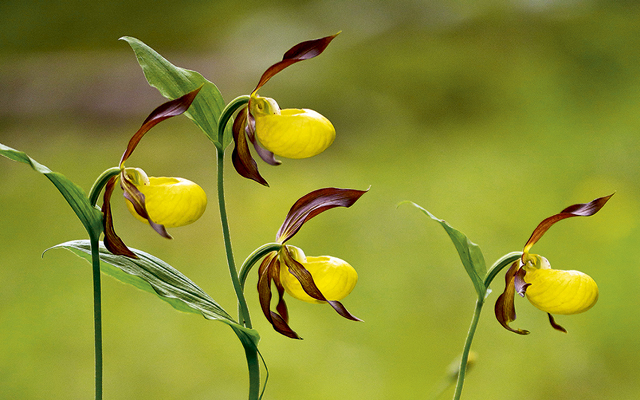How to grow lady slipper orchids
Mark Griffiths charts the lasting allure of the lady's slipper.

The orchid genus Cypripedium comprises 50 or so species distributed across the Northern Hemisphere. Herbaceous perennials, they inhabit grassland, bog and woods, many of them in climates as cool as ours and some in regions with far harsher winters.
They produce slender rhizomes that end in collars of fleshy but fragile roots. These surround the growth buds that break the soil surface in spring, rapidly developing as leafy shoots before beginning to die back around high summer.
Earlier, in May or June, they’ll have borne spectacular flowers. In these, the lowermost petal differs from the other segments in colour, size and shape. Termed the lip, it’s a large, inflated pouch, an adaptation that lures pollinators and imprisons them until they find the escape route — one that forces them to brush past and pick up the sticky pollen and carry it to its intended destination.
The shape of the lip inspired 16th-century botanists to christen the sole European species Calceolus Mariae (‘The Virgin Mary’s little shoe’). John Gerard (about 1545–1612) translated this as ‘Our Lady’s Slipper’, which evolved into plain lady’s slipper. The Swedish botanist Linnaeus also had divine footwear in mind when, in 1753, he gave this orchid its current scientific name, Cypripedium calceolus. By Cypripedium, he meant ‘Venus’s slipper’.
It’s easy to see why they all thought it sacred. This glorious species can stand more than 1ft tall and bear flowers a good 4in across. Its petals are silken, slender-pointed, sinuous to spiralling and somewhere in colour between chocolate and aubergine — all except for the lip, which is brilliant brimstone. Sacred it seemed, but, alas, it wasn’t sacrosanct.
For Victorians and Edwardians, Cypripedium species were the pride of rock and bog garden, our native C. calceolus included. They plundered its English sites — woodland fringes on limestone in the North. In the 20th century, this collecting, combined with loss of habitat and increased grazing, reduced the wild population to a single specimen.
In the 1990s, Kew scientists took action, mass-propagating the solitary wildling and plants of English origin that had survived in gardens. As a result, hundreds of lady’s slippers have been reintroduced to their old haunts, where their condition is perilous but promising.
Exquisite houses, the beauty of Nature, and how to get the most from your life, straight to your inbox.
Using the same techniques, commercial growers began producing a range of Cypripedium species. So it was that these orchids, which had rightly been banned if collected from the wild, became legally and sustainably available. They’re now offered by several British growers, notably Edrom Nurseries, Berwickshire (01890 771386; www.edrom-nurseries.co.uk), and Laneside Hardy Orchids, Lancashire (01995 605537; www.lanesidehardyorchids.com).
Continental firms are spawning hybrids as well as selections of the species and selling them into the UK retail trade. It still feels strange to see lady’s slippers at my local garden centre — like finding a unicorn at a horse sale. But, apart from the fact that they’re not British-grown, it’s cause for rejoicing.
There’s tremendous variety in Cypripedium, in terms both of looks and requirements. Many are best grown in pots in an alpine house or cold frame. Some of the finest, however, will not only survive in the open garden, but live for many years, gradually building into breathtaking clumps and colonies.
The Taiwanese C. formosanum runs around in the damp leaf litter of our bamboo grove. We provide for its worrying habit of sprouting before the last hard frosts by mulching it with compost — a wise precaution for all outdoor slipper orchids. It repays us in fan-like foliage and great bobbing blooms with sugar pink, botoxed lips.
Beside our pond, the North American C. reginae flourishes in a spot that’s sunny, peaty and moist, but never waterlogged for long. Held high at about 24in, its flowers combine pristine white petals with pouting magenta lips. Other slippers trip among our hostas, Tricyrtis and ferns, under trees and shrubs, with morning or dappled sun, and in soil that’s slightly acid, damp but well-drained and not rocket fuel-fertile. For this, we like C. kentuckiense, which is tall, with twisting, toffee-tricked petals and custard lips, and sturdy hybrids such as the cranberry-and-cream Cypripedium Gisela.
Then there’s the semi-shaded mound of leafmould, grit and loam laid over rubble; it’s our equivalent of a limestone rockery with humusy niches. Here She lives, just stirring now among the pasqueflowers, periwinkle and Bowles’s golden grass: Cypripedium calceolus, our very own legal and, if necessary, replaceable lady’s slipper.

Join us for an exclusive weekend in Cornwall
This autumn why not join Country Life on the beautiful Boconnoc estate for a wonderful weekend away.